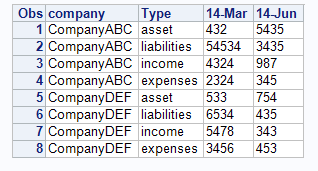- Home
- /
- Programming
- /
- SAS Procedures
- /
- Transposing Data-
- RSS Feed
- Mark Topic as New
- Mark Topic as Read
- Float this Topic for Current User
- Bookmark
- Subscribe
- Mute
- Printer Friendly Page
- Mark as New
- Bookmark
- Subscribe
- Mute
- RSS Feed
- Permalink
- Report Inappropriate Content
Hi everyone,
I'm trying to transpose the following table into a certain format described below. I haven't been able to figure it out, so decided to seek some advice. So here's what data looks like;
field1 | field2 | date |
CompanyABC | company | Mar-14 |
432 | asset | Mar-14 |
54534 | liabilities | Mar-14 |
4324 | income | Mar-14 |
2324 | expenses | Mar-14 |
CompanyABC | company | Jun-14 |
5435 | asset | Jun-14 |
3435 | liabilities | Jun-14 |
987 | income | Jun-14 |
345 | expenses | Jun-14 |
CompanyDEF | company | Mar-14 |
533 | asset | Mar-14 |
6534 | liabilities | Mar-14 |
5478 | income | Mar-14 |
3456 | expenses | Mar-14 |
CompanyDEF | company | Jun-14 |
754 | asset | Jun-14 |
435 | liabilities | Jun-14 |
343 | income | Jun-14 |
453 | expenses | Jun-14 |
and this is what I'm after;
company | Mar-14 | Jun-14 | |
asset | CompanyABC | 432 | 5435 |
liabilities | CompanyABC | 54534 | 3435 |
income | CompanyABC | 4324 | 987 |
expenses | CompanyABC | 2324 | 345 |
asset | CompanyDEF | 533 | 754 |
liabilities | CompanyDEF | 6534 | 435 |
income | CompanyDEF | 5478 | 343 |
expenses | CompanyDEF | 3456 | 453 |
Can anyone help?
Accepted Solutions
- Mark as New
- Bookmark
- Subscribe
- Mute
- RSS Feed
- Permalink
- Report Inappropriate Content
I think I might want the new "date" variable to be numeric but you did not specify and the following does not do that. That could be fixed.
I named the column you did not label "Type" to show how the column can be named in PROC TRANSPOSE>
infile cards dsd;
input (field1-field2)(:$16.) date :$6.;
cards;
CompanyABC,company,14-Mar
432,asset,14-Mar
54534,liabilities,14-Mar
4324,income,14-Mar
2324,expenses,14-Mar
CompanyABC,company,14-Jun
5435,asset,14-Jun
3435,liabilities,14-Jun
987,income,14-Jun
345,expenses,14-Jun
CompanyDEF,company,14-Mar
533,asset,14-Mar
6534,liabilities,14-Mar
5478,income,14-Mar
3456,expenses,14-Mar
CompanyDEF,company,14-Jun
754,asset,14-Jun
435,liabilities,14-Jun
343,income,14-Jun
453,expenses,14-Jun
;;;;
run;
proc transpose data=company out=company2;
by date notsorted;
var field1;
id field2;
run;
proc transpose data=company2 out=company3 name=Type;
by company;
var asset--expenses;
id date;
run;
proc print;
run;

- Mark as New
- Bookmark
- Subscribe
- Mute
- RSS Feed
- Permalink
- Report Inappropriate Content
I think I might want the new "date" variable to be numeric but you did not specify and the following does not do that. That could be fixed.
I named the column you did not label "Type" to show how the column can be named in PROC TRANSPOSE>
infile cards dsd;
input (field1-field2)(:$16.) date :$6.;
cards;
CompanyABC,company,14-Mar
432,asset,14-Mar
54534,liabilities,14-Mar
4324,income,14-Mar
2324,expenses,14-Mar
CompanyABC,company,14-Jun
5435,asset,14-Jun
3435,liabilities,14-Jun
987,income,14-Jun
345,expenses,14-Jun
CompanyDEF,company,14-Mar
533,asset,14-Mar
6534,liabilities,14-Mar
5478,income,14-Mar
3456,expenses,14-Mar
CompanyDEF,company,14-Jun
754,asset,14-Jun
435,liabilities,14-Jun
343,income,14-Jun
453,expenses,14-Jun
;;;;
run;
proc transpose data=company out=company2;
by date notsorted;
var field1;
id field2;
run;
proc transpose data=company2 out=company3 name=Type;
by company;
var asset--expenses;
id date;
run;
proc print;
run;

- Mark as New
- Bookmark
- Subscribe
- Mute
- RSS Feed
- Permalink
- Report Inappropriate Content
i think this is it. I never really thought I could do this in two steps (to me it seems ingenious now ![]() ). really appreciate the reply.
). really appreciate the reply.
- Mark as New
- Bookmark
- Subscribe
- Mute
- RSS Feed
- Permalink
- Report Inappropriate Content
Quick, without testing:
data intermed;
set have;
retain company;
if field2 = "company" then company = field1;
else output;
run;
proc sort data=intermed;
by company field2;
run;
data want (keep=company category mar_14 jun_14);
set intermed (rename=(field2=category));
by company category;
if first.category
then do;
mar_14 = 0;
jun_14 = 0;
end;
select (date);
when ('Mar-14') mar_14 = field1;
when ('Jun-14') jun_14 = field1;
otherwise;
end;
if last.category then output;
run;
In the last data step, the possible dates may be covered by a suitable macro.
- Mark as New
- Bookmark
- Subscribe
- Mute
- RSS Feed
- Permalink
- Report Inappropriate Content
Hello,
Another solution:
proc sql noprint;
select distinct cat('_' ,substr(date,1,2),substr(date,4,3)) into :datevar separated by ' ' from have ;
select distinct cat('max(_' ,substr(date,1,2),substr(date,4,3),') as _',substr(date,1,2),substr(date,4,3)) into :datevarsql separated by ',' from have ;
quit;
%put &datevar &datevarsql;
data int1;
retain compint ;
array trdata{*} $ &datevar;
set have;
if notdigit(strip(field1)) then compint=field1;
else
do;
financial_data=field2;
company=compint;
do i=1 to &sqlobs ;
if (vname(trdata{i})=cat('_' ,substr(date,1,2),substr(date,4,3))) then trdata{i}= field1;
end;
output;
end;
drop compint field1 field2 date i;
run;
proc sql noprint;
create table want as
select company,financial_Data, &datevarsql
from int1
group by company,financial_Data;
quit;
April 27 – 30 | Gaylord Texan | Grapevine, Texas
Registration is open
Walk in ready to learn. Walk out ready to deliver. This is the data and AI conference you can't afford to miss.
Register now and lock in 2025 pricing—just $495!
Learn the difference between classical and Bayesian statistical approaches and see a few PROC examples to perform Bayesian analysis in this video.
Find more tutorials on the SAS Users YouTube channel.
SAS Training: Just a Click Away
Ready to level-up your skills? Choose your own adventure.



